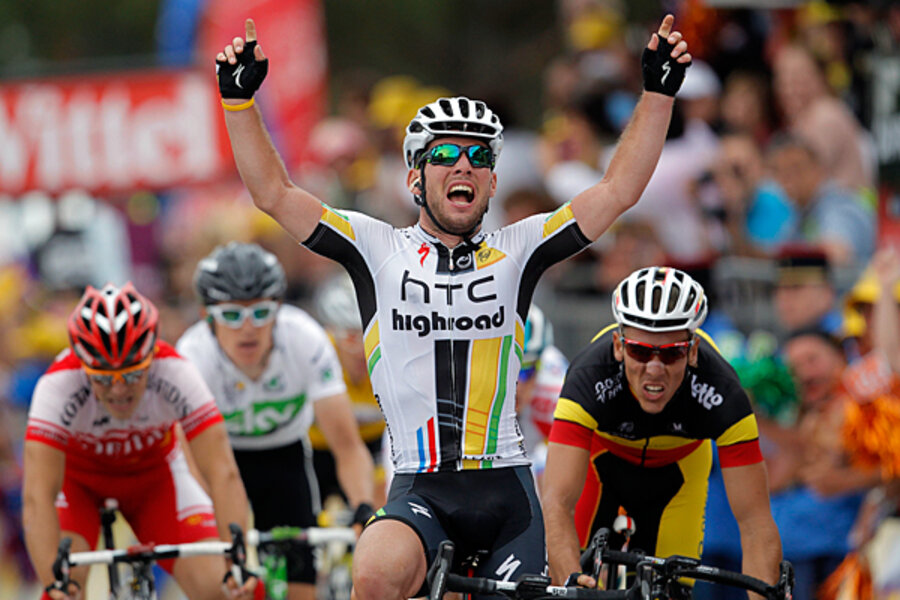What's that ruckus at the Tour de France? Sprint racing at its best.
Loading...
| Lisieux, France
From afar, sprint finishes at the Tour de France look like unbridled chaos: a pack of riders flying down the final miles, legs pumping furiously, at speeds upward of 40 miles per hour. There’s no time for politesse – elbows fly, knees knock and, occasionally, a head-butt is thrown.
In the closing meters, seemingly out of nowhere, one sprinter darts to the front, cranking the pedals until he crosses the finish line victorious, arms raised in jubilation.
Bravado, timing, and a taste for the spotlight seem prerequisites for successful sprinters.
They’re known as cycling’s prima donnas – riders with egos as big as their bulging quadriceps.
The first week of the Tour de France is traditionally their time to shine, but this year's course is unusual. The first six stages hugged the tight corners and steep hills of Brittany and Normandy, rewarding more versatile riders.
Two sprinters, including Team HTC-Highroad’s Mark Cavendish, managed to capture stages against the odds. But right now the green jersey – worn by the race’s sprint points leader – is on the back of Philippe Gilbert, who’s not a sprint specialist.
His lead will be challenged today, however, as the peloton rides through the flat, broad roads of the Loire Valley toward a more typical sprint finish in Châteauxroux, where the Briton Cavendish won his first-ever Tour stage in 2008.
Since then, he's captured 16 stages, including Wednesday's, which he proclaimed a win against his “doubters” in the press.
Indeed, in a sport known for its soap opera headlines, these easily maligned riders have a special penchant for melodramatics, on and off the bike.
Journalists are often used as mouthpieces as petulant sprinters trade barbs like quarreling celebrities.
Earlier this week, French sprinter Romain Feillu criticized Cavendish as “arrogant towards everybody”; Cavendish had previously labeled Feillu a “kamikaze” sprinter after the Frenchman blocked his path to victory in Stage 3, won instead by American Tyler Farrar. (Farrar, an exception to the sprinter stereotype, is often called a “gentleman” by fellow riders.)
Sprinter rivalries have been known to get out of hand. Italy’s Mario Cipollini, one of the most decorated sprinters of the last two decades, was ejected from the 2000 Tour of Spain after punching a rider who had criticized him the previous day.
Teams scout out courses, develop plan of attack
Many of these preening tough-men are also sharp tactical minds. Like many riders, Cavendish reconnoiters select stages of the Tour course each year to get timing, speed, and angle of attack down.
At the end of May – more than a month before the race kicked off – Cavendish and his HTC-Highroad teammates traveled to France’s west coast to ride the finishes of each early stage.
In addition to such preparation, teams discuss each stage’s tactics on the bus before each stage, often lining up multiple scenarios for the sprint finish – including which team member will go for the win.
Farrar, who sprinted to victory in Monday’s Stage 3, was just one of the options his Garmin-Cervélo team had for the final sprint — current race leader Thor Hushovd, twice a green jersey winner, also had the green light.
Instead of taking the stage for himself, though, Hushovd assessed the scenario down the stretch and decided to pace Farrar to his first-ever Tour de France win.
“We made a plan this morning and Thor had the option to [lead out],” said team director Jonathan Vaughters. “The work he did was exceptional.”
Even the most egotistical of sprinters knows that having a good group of pace men, or lead-out train, is indispensable.
Like offensive linemen in football, riders in the lead-out train act as bodyguards. They shield the sprinter from the wind, allowing him to conserve energy for the final push, and jockey for space to put him in the best position down the stretch.
In the final miles, the lead-out train peels off one by one, until the sprinter makes his mad dash to the finish.
Protection can get overzealous at times – in Stage 11 of last year’s Tour, Cavendish’s chief lead-out man Mark Renshaw was disqualified from the race for head-butting another rider down the stretch.
Cavendish's unlikely win
Sometimes, however, all this preparation and teamwork goes for naught.
During the final miles of his Stage 5 win on Wednesday, Cavendish’s HTC-Highroad lead-out train was broken up by the windy, twisting final climb.
Though safely ensconced at the front of the peloton, Cavendish was without allies and facing a nasty headwind.
What was the team’s pre-race contingency plan for that?
“Cav pushes the turbo button on his handlebar and does it on his own,” HTC-Highroad team director Rolf Aldag told The Christian Science Monitor with a smile after the stage.
Indeed, Cavendish stood on his pedals and powered past rivals to the win.
If the unusual finish fazed him, it didn’t show.
He was a typically enigmatic sprinter in the ensuing press conference – greeting his interpreter with kisses, dedicating the win to Amber, his recently deceased golden retriever, and cursing at a journalist.





